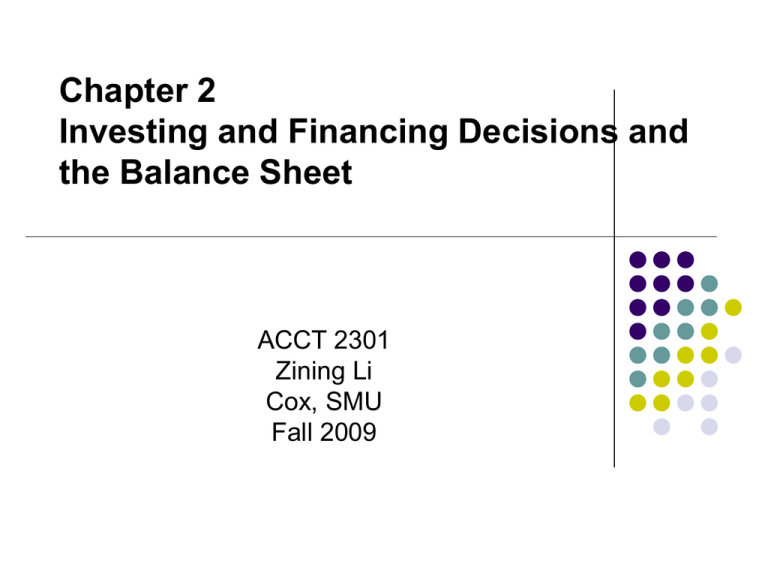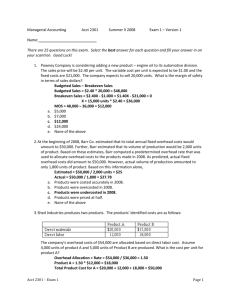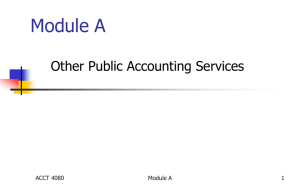Loaned $500 to an employee who signed a note
advertisement

Chapter 2 Investing and Financing Decisions and the Balance Sheet ACCT 2301 Zining Li Cox, SMU Fall 2009 Zining Li ACCT 2301 FALL 2009 Cox School of Business, SMU What do we hope to learn Characteristics of Financial Accounting Information How does a company record business transactions (Transactional Analysis) How does a company keep track of accounting records Acct 2301 Li Fall 09 1 Accounting – Who Sets the Rules? Securities and Exchange Commission (SEC) Legal authority to set accounting rules for publicly traded companies Delegated responsibility to the accounting profession Financial Accounting Standards Board (FASB) Currently the standards setting body GAAP Acct 2301 Li Fall 09 2 Qualitative Characteristics of Financial Accounting Information Relevant Reliable Representational faithfulness Verifiable Comparable Specific / Timely For same company Across different company Consistent Same rules over time Acct 2301 Li Fall 09 3 Elements Assets: economic resources that are measurable; owned or controlled by the company that will bring future benefits Liabilities: economic obligations Stockholders’ equity (contributed capital + retained earnings) Revenues: inflow of assets or settlement of liabilities from on-going business Expenses: decreases (increases) in assets (liabilities) from on-going business Gains (Losses): from peripheral activities Acct 2301 Li Fall 09 4 Assumptions Separate-entity assumption Unit-of-measure Continuity (going-concern) Time period Acct 2301 Li Fall 09 5 Principles Historical Cost (the Balance Sheet) Revenue Recognition (the Income Statement) Matching(the Income Statement) Full disclosure Acct 2301 Li Fall 09 6 Constraints Cost benefit Materiality Conservatism Industry practice Acct 2301 Li Fall 09 7 How does a Company Record Business Transactions? (1) Definition of Transaction Economic events that impact a business entity External v.s. Internal NOT all economic events are reflected in financial statements! Acct 2301 Li Fall 09 8 How does a Company Record Business Transactions? (2) Let’s start with A= L + SE Duality of Effects Each transaction affects at least two items (accounts) The accounting equation always remains in balance after each transaction Acct 2301 Li Fall 09 9 Determining the Financial Statement Effects of Following Transactions • Received investment of $24,000 cash by organizers and distributed stock to them • Purchased $8,000 of equipment, paying $1,000 in cash and signing a note for the rest • Loaned $500 to an employee who signed a note • Borrowed $7,000 cash from a bank by signing a note • Purchased $15,000 of land; paid $4,000 in cash and signed a mortgage note for the balance Acct 2301 Li Fall 09 10 Event a. b. c. Assets 1)Cash (F) = +8,000 2)Cash (I) –1,000 +500 3)Cash (I) –500 e. 5)Land +7,000 +15,000 5)Cash (I) –4,000 Assets $49,000 = Stockholders’ Equity 1)Contri. capital 3)Note receivable 4)Cash (F) + +24,000 2)Equipment d. Liabilities 2)Notes payable +7,000 4)Notes payable +7,000 5)Mortgage note payable Liabilities $25,000 Acct 2301 Li Fall 09 +24,000 +11,000 + Stockholders’ Equity $24,000 11 Debits, Credits and Taccounts? T-account: We can use a “T” to represent an account Debit (Dr) Means the left side of an account Numbers put on the left side of an account are debits Credit (Cr) Means the right side of an account Numbers put on the right side of an account are credits What do we mean when we say “to credit (debit) an account”? Acct 2301 Li Fall 09 12 Debits, Credits, &Accounting Equation Assets + Dr. Cr. = Liabilities + Shareholders’ Equity (Contr. Cap. + R/E) Dr. + Cr. Acct 2301 Li Fall 09 Dr. + Cr. 13 Record Journal Entries Information recorded in a journal entry: Date of transaction Accounts affected Dollar amounts of debits and credits A brief explanation of the transaction (can be skipped for our purposes) Remember: Assets = Liabilities + Owner’s Equity Debits = Credits In every journal entry there are equal dollar amounts of debits and credits. Acct 2301 Li Fall 09 14 Received investment of $24,000 cash by organizers and distributed stock to them Transaction Account Titles #1 Dr. Cash Debits Credits 24,000 Cr. Contributed Capital Acct 2301 Li Fall 09 24,000 15 Purchased $8,000 of equipment, paying $1,000 in cash and signing a note for the rest Transaction Account Titles Debits #2 Dr. Equipment Cr. Notes Payable Cr. Cash Acct 2301 Li Fall 09 Credits 8,000 7,000 1,000 16 Loaned $500 to an employee who signed a note Transaction Account Titles Debits #3 Dr. Notes Receivable Cr. Cash Credits 500 500 Acct 2301 Li Fall 09 17 Borrowed $7,000 cash from a bank by signing a note Transaction Account Titles #4 Dr. Cash Debits Credits 7,000 Cr. Notes Payable Acct 2301 Li Fall 09 7,000 18 Purchased $15,000 of land; paid $4,000 in cash and signed a mortgage note for the balance Transaction Account Titles Debits #5 Dr. Land Cr. Mortgage notes payable Cr. Cash Acct 2301 Li Fall 09 Credits 15,000 11,000 4,000 19 T-account Cash Notes Receivable 0 0 24,000 500 1,000 500 500 7,000 4,000 25,500 Acct 2301 Li Fall 09 20 Land Equipment 0 0 15,000 8,000 15,000 8,000 Acct 2301 Li Fall 09 21 Notes Payable Mortgage Notes Payable 0 7,000 0 11,000 7,000 14,000 11,000 Acct 2301 Li Fall 09 22 Contributed Capital 0 24,000 24,000 Acct 2301 Li Fall 09 23 Record Transactions: Summary To record a transaction, Identify items (accounts) that are affected Determine the direction of impact on each account (increase or decrease) Verify that the accounting equation (A=L+SE) remains in balance Example To start, focus on investing and financing activities Acct 2301 Li Fall 09 24 How is the Cash Flow Statement affected by Investing and Financing Activities? Investing Cash Flows Outflows: cash paid for acquisition of long-term assets Inflows: cash proceeds from sale of long-term assets Financing Cash Flows Inflows: cash received from issues of common stock and long-term debts Outflows: cash paid directly related to issues of common stock and long-term debts. E.g. retirement of long-term debts, repurchase of common stock, and cash dividend Acct 2301 Li Fall 09 25











